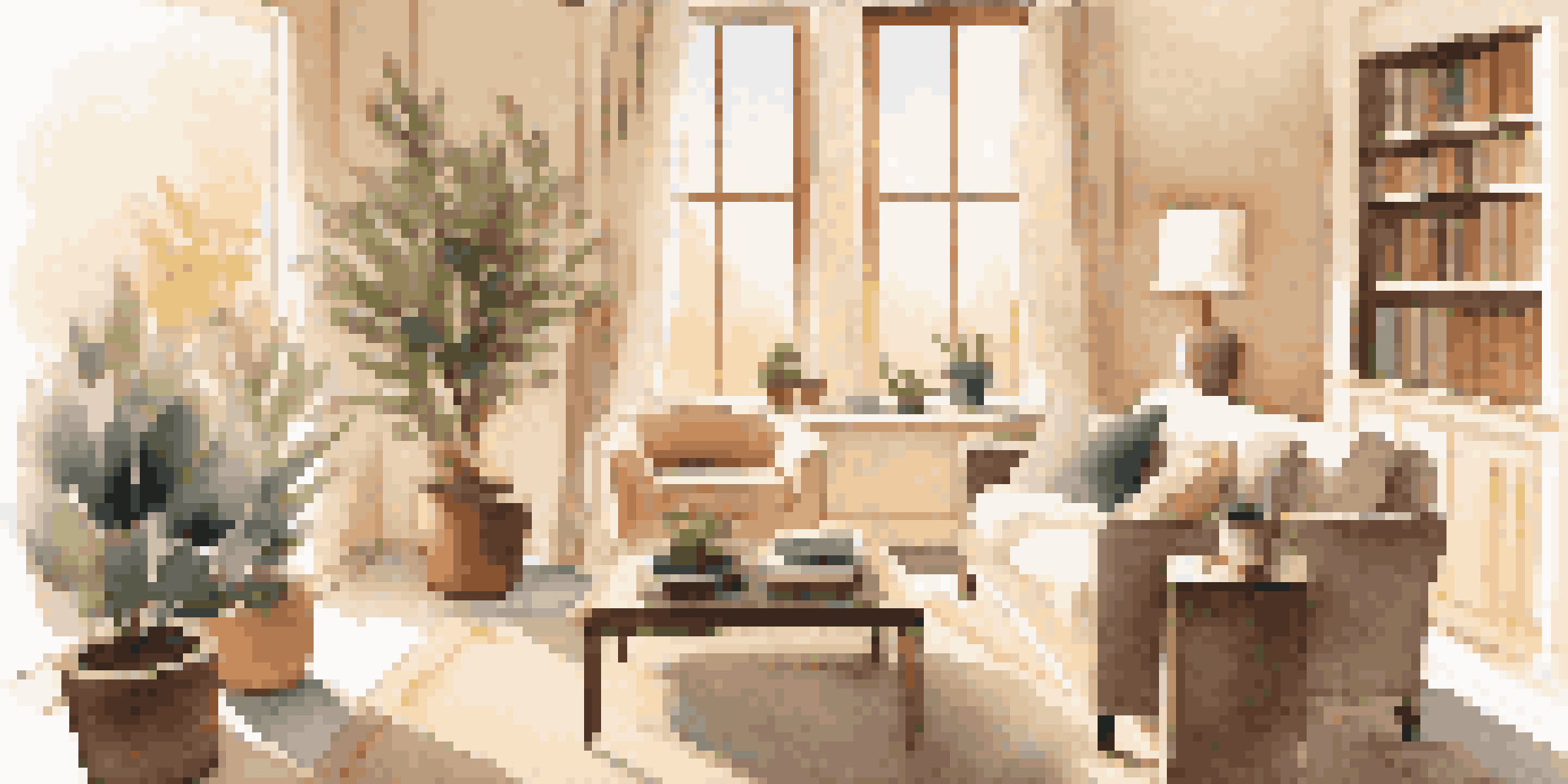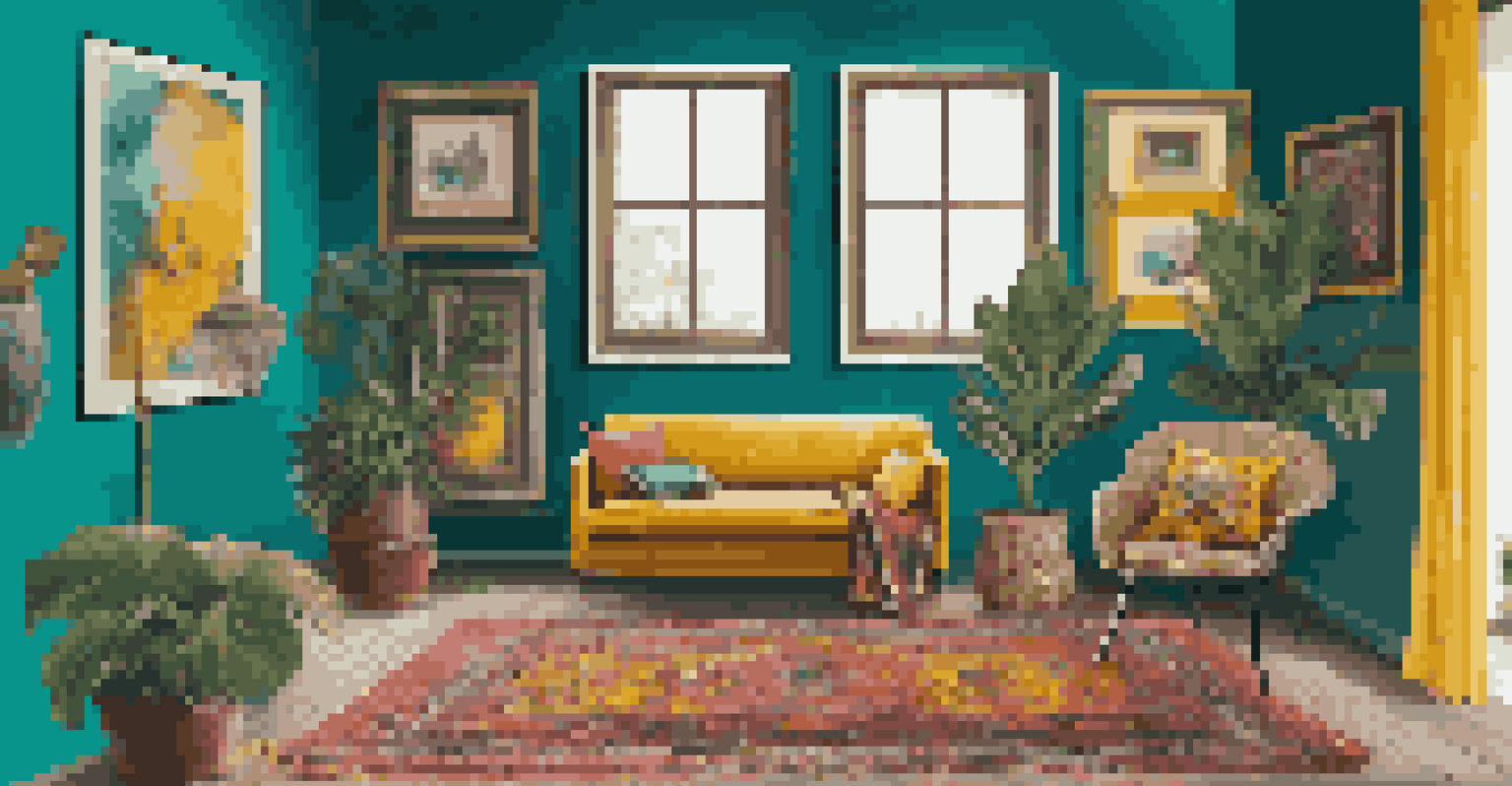The Evolution of Color Palettes in Contemporary Interiors

The Historical Roots of Color in Interior Design
Color has always played a crucial role in interior design, with historical influences shaping our choices today. From the earthy tones of ancient cave dwellings to the vibrant hues of Renaissance art, each era has left its mark. Understanding these roots helps us appreciate the complexity and emotional impact of color in our spaces.
Color is the keyboard, the eyes are the harmonies, the soul is the piano with many strings.
In the early 20th century, the introduction of new pigments revolutionized design, allowing for more diverse color palettes. Artists and designers began experimenting with bold colors and unexpected combinations, paving the way for contemporary styles. This evolution signifies not just a shift in aesthetics, but also in the way we perceive our living environments.
Today, we can look back at these historical influences and see how they inform modern design choices. The palettes we choose often reflect a blend of past traditions and contemporary trends, creating a dialogue between old and new. This rich history serves as a backdrop for the innovative color stories we see in contemporary interiors.
The Rise of Minimalism and Neutral Palettes
Minimalism has dramatically influenced contemporary interior design, leading to a surge in neutral color palettes. Soft whites, grays, and beiges create calming environments that promote tranquility and simplicity. This trend reflects a collective desire for peace in our often chaotic lives, making neutral tones a popular choice for many homeowners.

However, minimalism doesn't mean blandness. Designers are increasingly using texture and subtle variations within these palettes to add depth and interest. Think of a cozy living room featuring different shades of beige, paired with a soft cream sofa and a textured wool throw. These subtle contrasts can evoke warmth and comfort, proving that minimalism can still have personality.
Historical Color Influences
Understanding the historical roots of color helps us appreciate its emotional impact in contemporary interior design.
This focus on neutral palettes also allows for flexibility in decor. Homeowners can easily change accessories or artwork without clashing with their walls, making it a practical choice. As we embrace minimalism, these neutral tones will likely continue to dominate the landscape of contemporary interiors.
Bold Colors and Eclectic Combinations
In contrast to minimalism, there's been a resurgence of bold colors and eclectic combinations in contemporary interiors. This trend encourages homeowners to express their individuality through vibrant hues and unexpected pairings. Think of a bright teal accent wall paired with mustard yellow cushions—this playful approach to color can transform a space into a personal sanctuary.
The best color in the whole world is the one that looks good on you.
Eclectic design celebrates the beauty of mixing styles, patterns, and colors, creating a unique narrative within each home. By blending vintage pieces with modern decor, homeowners can craft a space that feels both curated and lived-in. This approach not only showcases personality but also fosters a sense of creativity and experimentation.
As we move forward, the embrace of bold colors reflects a broader cultural shift toward authenticity and self-expression. The interiors we create speak to our identities, allowing us to showcase our stories through color. This trend invites everyone to let their imagination run wild, creating spaces that are as diverse as the people who inhabit them.
The Influence of Technology on Color Trends
Technology has revolutionized how we approach color selections in interior design. Digital tools and apps allow homeowners and designers to visualize color combinations in real time, making the decision-making process more accessible and enjoyable. This innovative approach eliminates guesswork, ensuring that the chosen palette resonates with the desired aesthetic.
Moreover, online platforms and social media have democratized design inspiration. Platforms like Instagram and Pinterest enable users to discover trending color palettes and styles from around the world. This exposure not only broadens our understanding of color but also allows us to adapt global influences to fit our personal tastes.
Minimalism and Neutral Tones
The rise of minimalism has led to a preference for neutral palettes that promote tranquility while allowing for personal expression through texture.
As technology continues to evolve, it will undoubtedly shape future color trends in interesting ways. Virtual reality experiences may soon allow us to immerse ourselves in potential color choices before making a commitment. This intersection of technology and design promises to keep the evolution of color palettes dynamic and exciting.
Sustainable Colors: Eco-Friendly Choices in Design
As environmental consciousness grows, so does the desire for sustainable color choices in interior design. Many designers are now turning to eco-friendly paints and materials that minimize harm to the planet. These options not only promote sustainability but often offer rich, natural hues that enhance the beauty of any space.
The rise of biophilic design—where nature is integrated into living spaces—has also influenced color palettes. Shades inspired by nature, like earthy greens and soft blues, create a soothing atmosphere that fosters well-being. Incorporating these colors brings the outside in, creating a harmonious connection with the environment.
Sustainability doesn't compromise on style; rather, it encourages a more thoughtful approach to design. By choosing eco-friendly options, homeowners can create beautiful interiors that reflect their values. This shift signifies a commitment to both personal aesthetics and the health of our planet.
Cultural Influences on Color Choices
Color choices in contemporary interiors are increasingly influenced by cultural backgrounds and traditions. As our world becomes more interconnected, the blending of various cultures is reflected in our design decisions. For example, vibrant colors often found in African textiles or the earthy tones of Japanese minimalism can inspire modern interiors.
This cultural exchange enriches our understanding of color and enhances the depth of our spaces. By incorporating elements from different cultures, homeowners can create a narrative that celebrates diversity. This approach not only adds visual interest but also fosters appreciation for global traditions.
Cultural and Technological Trends
Contemporary interiors are increasingly shaped by cultural influences and technology, leading to diverse, personalized color choices.
As we continue to embrace multicultural influences, the color palettes of contemporary interiors will likely evolve further. This dynamic interplay of colors will reflect our shared experiences and stories, allowing us to create spaces that resonate on a deeper level.
Future Trends: The Next Chapter in Color Palettes
Looking ahead, it's exciting to speculate about the future of color palettes in contemporary interiors. Emerging trends suggest a shift toward deep, rich hues that evoke emotion and warmth. Colors like deep emerald, navy blue, and burgundy are making a comeback, inviting a sense of luxury and comfort into our homes.
Additionally, the integration of technology may lead to more personalized color palettes. Imagine smart homes that adjust color temperatures based on time of day or mood, creating dynamic environments that continuously evolve. This possibility could redefine how we interact with our spaces and the colors we choose.

As we move forward, the evolution of color palettes will reflect not only aesthetic preferences but also cultural and technological shifts. By embracing these changes, we can create interiors that are not only beautiful but also meaningful, shaping the way we experience our homes.